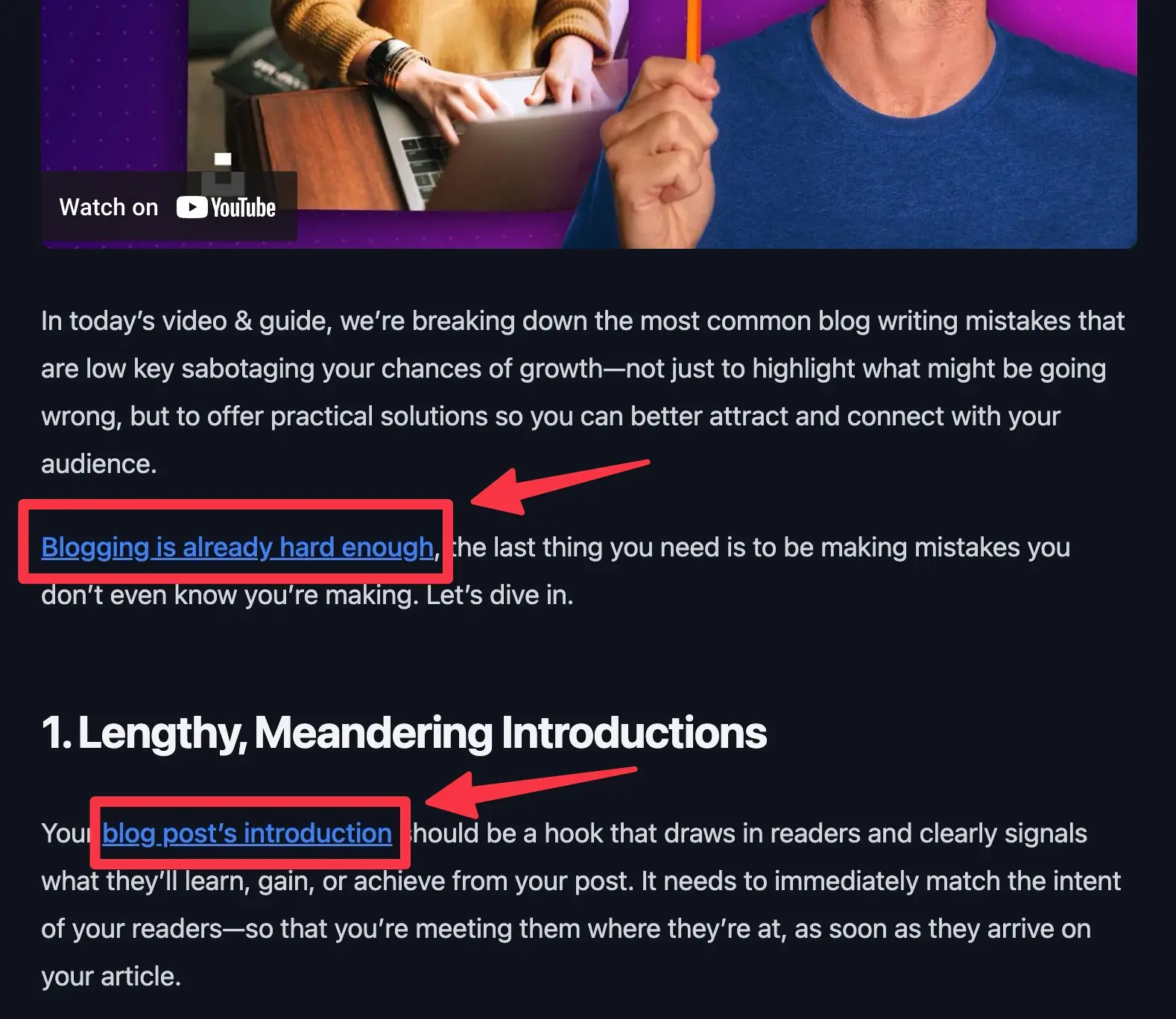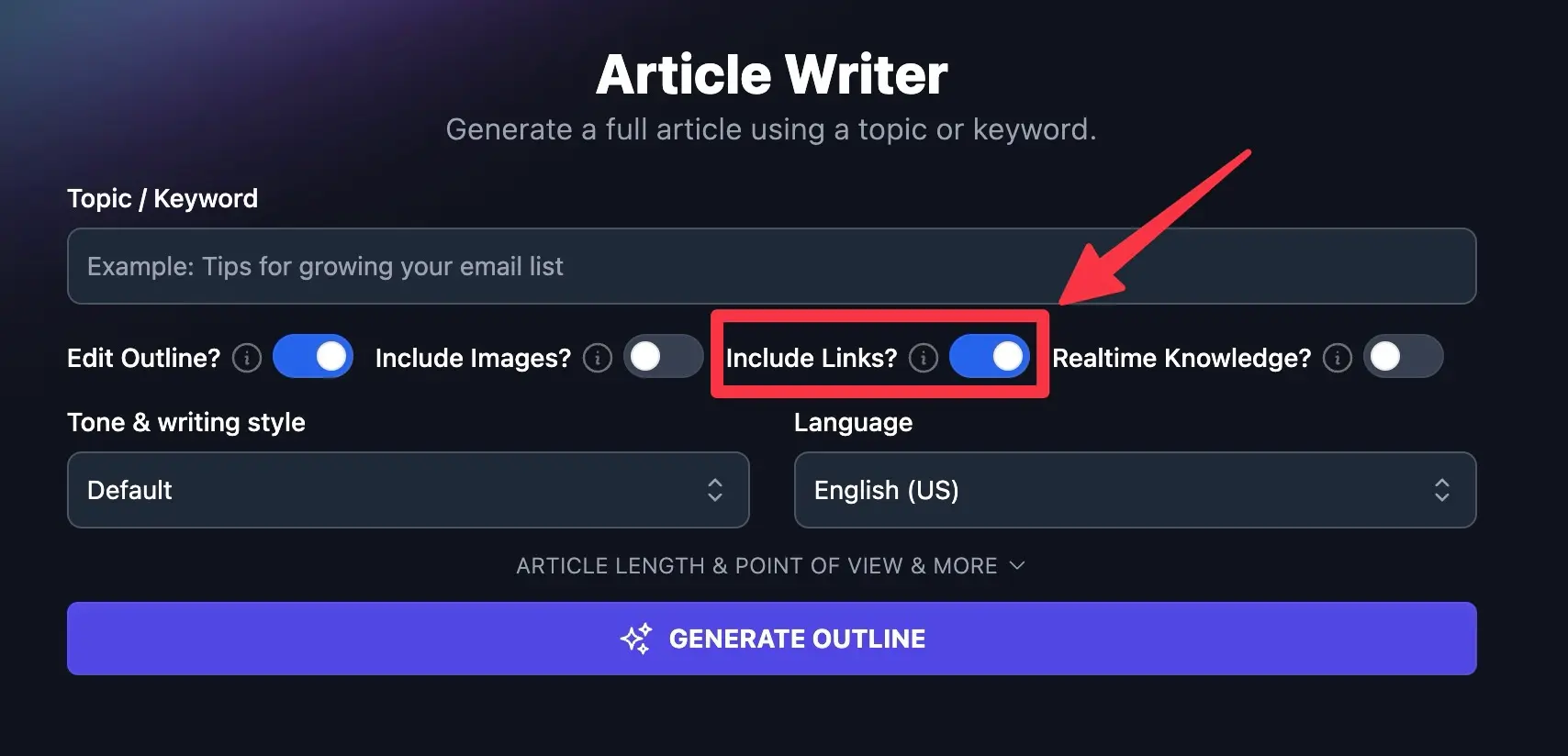7 AI Blogging Mistakes to Avoid (When Using AI Tools for Content Creation)

ChatGPT came out in November of 2022 and changed a lot of things for creators, overnight. Andy and I started using AI tools in our content creation process immediately. We’ve seen (and made) a lot of the biggest AI blogging mistakes, first-hand.
We’ve also learned what works and what doesn’t. We’ve honed our own AI blogging process into a speedy workflow that uses the tools we’ve made inside RightBlogger, to create first drafts of long-form, SEO-optimized blog posts that rank & get traffic faster. We’ve built tools like the YouTube Video to Blog Post Generator that let’s us quickly repurpose videos into actionable written content for search engines.
However, we also know firsthand that the race to create (more) great content and attract a wider audience, is fraught with pitfalls. It’s easy to stumble into seemingly subtle mistakes that can undermine your game plan.
Here’s a rundown of the seven most common AI blogging mistakes you should avoid when using artificial intelligence tools in your content creation process.
Now, let’s take a closer look at each of these AI blogging mistakes and examine how to avoid them in your own content creation process.
1. Over-Reliance on AI Tools
Have you ever read something on a blog, publication, or website and it just felt… off? Like the writer just repackaged a generic template and used a bunch of words that’d never appear in a real human-to-human conversation? That’s often the result of over-relying on AI tools.
These tools are fantastic for creating content faster, but they’re also in their infancy. They can’t do everything for you—and honestly, they shouldn’t. You are what makes your content unique & special.

Most AI-generated first drafts, no matter how detailed your instructions, will lack the personal touch and vibrance that distinguishes truly compelling content from the painfully average.
Why this AI blogging mistake is a problem:
- Lack of Personality: When you let AI handle everything without weaving yourself into your content, it’s almost guaranteed to lack your unique voice and style. Features like RightBlogger’s MyTone can help a lot, but there’s no escaping the need to embed your take on a topic, into the creation process. Don’t forget, your readers are going to feel connected to you because of your unique perspective, not the “opinions” of AI technology.
- Generic Delivery: If you’re using AI to create video scripts, podcast scripts, or any other content that requires a personal delivery of the AI writing you generate, relying too heavily on the words AI chooses can make your delivery feel detached and impersonal.
The Solution: When I first started experimenting with weaving AI tools into my writing process, I noticed right away that my personality wasn’t shining through the way it used to. It took me a few go-rounds to realize that my readers were missing “me” in my content.
This is what inspired us to create the MyTone Feature inside RightBlogger, which learns from your writing & helps your creations sound more like you over time:

I now use AI to generate ideas and write first drafts of some articles, but the stories, examples, and the voice are all mine. It takes more time than just generating an AI article and hitting publish, but ultimately it still saves me a ton of time compared to starting each new post from scratch.
2. AI Hallucinations (Making Up Facts)
AI doesn’t just flawlessly deliver truth. Sometimes, it completely makes things up.

This is because many AI models function like advanced autocomplete systems. They can generate seemingly plausible, realistic-sounding, yet entirely fictional information, which can be a major problem if you’re not checking your AI-written first drafts.
Why AI hallucinations are a problem:
- Misinformation: Obviously, fabricated facts, information, and education can mislead your audience and will damage your credibility in the long run.
- Fact-Checking is a Must: Every piece of AI-generated content needs to be verified for accuracy. This extra step should be looped into your proofreading process. And while it adds time to your creation process, you’ll almost always still end up saving time.
Personal Example: Early on in my AI tool use, I spotted a suspicious statistic about social media use in an AI first draft. It sounded reasonable, but it didn’t cite the source. After double-checking (before publishing), it turned out to be made up.
3. Not Editing AI-Generated Content (Before Publishing)
As we’ve touched on already, AI Article Writers can kickstart your creation process by drafting content, but it’s important to consider these deliverables a first draft—not a final, publish-worthy piece.
🔑 To make truly great AI-assisted content, you’ll need to spend time editing your first drafts and weaving in your personality to make it truly yours.

Why this AI blogging mistake is a problem:
- Quality Issues: AI-generated content often needs refinement and leveling up, in order to rise to my high quality publishing standards. Beyond just fact checking, you’ll wanna take time to rewrite some words, sentences, even paragraphs into your own voice. Or perhaps you’ll be inspired by a dry AI section, to pop in with a personal story or anecdote that dramatically improves the impact of your content.
- Lack of Depth: Without personal insights, stories, examples and revisions that can only come from your deep well of experience in the field you’re writing about, AI content often feels painfully surface-level. If your goal is to forge real, meaningful connections with your audience, it’s going to take your personal touch.
My AI Editing Strategy: I spend a significant amount of time editing every AI first draft I create, but I like this process a lot because I have an existing post structure to work with. Take care to weave in personal anecdotes and relevant examples that reflect your real life experiences & insights.
4. Bulk Posting AI Content
It’s tempting to consider scaling your SEO traffic by flooding your niche with 100s of AI-generated articles overnight, but a word of caution. This is an incredibly risky strategy, and I strongly advise against doing it with any website you care about.

Google has affirmed multiple times that there’s nothing wrong with using AI in your content creation process, but that the content does still need to meet “high quality standards” in order to be considered for indexing and ranking.
Bulk publishing of AI content, sight unseen, is almost certainly going to land your site in hot water eventually.
Why bulk AI publishing is a problem:
- SEO Penalties: Search engines, like Google and Bing, are getting better at identifying bulk-generated content. This can hurt your rankings, as you’ll be subject to a higher risk of manual actions and penalties that can erode any traffic gains you may have experienced at first.
- Loss of Personal Touch: Mass-produced content inherently lacks the depth and personalization that’s essential to building an audience that shows up to get your expertise on a subject.
The Solution: I’ve found that AI tools do speed up my content publishing process, but that there are limitations I’m willing to accept in order to keep my content feeling great. Spacing out your content publication and investing time in personalizing each piece will significantly boost your engagement and SEO performance in the long run.
Patience, my friend. It takes time to gain traction with blogging, and that’s ok.
5. Lack of Internal Linking
Most AI written articles will miss crucial elements like strategic internal linking, which is essential for both SEO and a better user experience. Internal links offer the opportunity to not only connect your web of content for search engine algorithms, but also provide valuable additional learning opportunities for your readers.

Why missing internal links is a problem:
- Orphaned Content: Without links, the posts and pages on your site won’t contribute to the overall site architecture, and are less likely to rank well in organic Google search results. When you include internal links, you’re giving search engines a signal that each post or page you link to, is important.
- Poor User Experience: Internal links guide your readers through your website, increasing engagement, session duration, and time on site. If someone reads three articles you’ve written in one sitting, compared to just one, that relationship has a much higher chance of growing.
How I Handle AI Internal Links: RightBlogger has an “Include Links” feature built into the Article Writer tool, and right now we’re working on adding the option to source relevant internal links from your library of web properties in your account.

Personally though, I know my content better than anyone else. I always make sure to manually insert internal links into my AI-written drafts, to help tie my content ecosystem together.
6. Creating Content on Unfamiliar Topics
It’s tempting to use AI to cover topics outside your area of expertise (or personal interest), simply because you’ve identified an opportunity that seems promising, but this practice inevitably leads to shallow and often inaccurate content.
For example, our Keyword Research Tool shows that an estimated 3,000+ people search for “how to bake a cake from scratch” every month… which is a tempting amount of traffic if I ran a baking blog. But I don’t know much of anything about baking a cake from scratch lol… just because there’s a traffic opportunity, doesn’t mean it’s the right topic for you to create content about:

Not to mention the fact that even if your AI-generated on topics outside your wheelhouse begin amassing traffic, you’re almost certainly going to burn out at some point. There’s no faking genuine interest for sustained periods of months or years. It’s best to stick with topics you genuinely care about—your audience will feel the love you have for the subject matter you’re covering.
Why this AI blogging mistake is a problem:
- Lack of Depth: You can’t fact-check effectively if you’re unfamiliar with the subject matter. Plus, you won’t be able to truly go deep into an explanation of a particular process or piece of advice, which will render your content significantly less useful than that of a true expert in the field you’re dabbling in.
- Audience Disconnect: Readers come to content creators for the unique insights we have to offer, not regurgitated information that can be found just anywhere online. Your informed take is what makes your content useful—lean into it by creating on topics you genuinely care about.
Lesson Learned: Early on in my blogging journey, I attempted starting multiple blogs on topics (like personal finance) that I was barely acquainted with, purely because I saw the potential for dollar signs. The results were always superficial content that failed to attract, let alone retain a real audience. I’ve since learned my lesson and stick to topics where I can provide real value to people, based on my own lived experiences.
7. Poor Prompting of AI Writing Tools
The quality of your AI-generated content depends heavily on the amount of input the tool receives. Vague or lackluster prompts and outlines will almost certainly lead to low-quality AI first drafts.

Inside RightBlogger, we’ve intentionally designed our creation tools to hedge against this AI blogging mistake. We’ve spent many hours curating all the behind-the-scenes prompts, giving a lot of structure and detail to the framework of any content piece you generate with our tools.
That said, there’s no escaping the need to weave in your own personal insights, expertise, and advice into the AI creation process, too. That’s where taking a few extra minutes to add your take into the Additional Instructions field, really pays dividends on the backend when you get a first draft that comes out rockin & rollin.

How to avoid this AI blogging mistake:
- Detailed Prompts: Providing clear, detailed instructions straight out the gates (whether you’re using RightBlogger’s structured approach or OpenAI ChatGPT‘s free-for-all), will dramatically improve your article quality on the first go. You’ll also get more accurate and relevant content, faster.
- Target Audience, Keywords, and Additional Instructions: Always specify who you’re writing each article for, what the target keyword phrase is (that you’d like to rank for in Google search results), and offer up as much detailed, additional instructions as you possibly can.
Avoid These AI Blogging Mistakes (and Get More Traffic) Today
Integrating AI into your content creation process can create a major lift in terms of productivity, maintaining a steady stream of content, and even in driving more traffic to your blog over time.

However, making these common AI blogging mistakes can actually send your site in the opposite direction. By avoiding these pitfalls, you’ll set yourself up for success—and make sure that your use of AI enhances, rather than detracts from your goals.
AI can be used to help produce content that’s both efficient to create, and deeply meaningful for your audience. But you have to care. That is why we created a whole free course to learn the foundation of AI for marketing and content creation.
Remember, the goal is to use AI as a tool to amplify your unique voice and insights, not to replace the personal touch that your audience will value most.
Is it okay to use AI to write blog posts, or will Google penalize my site?
Yes, it is okay to use AI to help write blog posts. Google cares most about quality, usefulness, and trust, not whether you used AI.
The risk is publishing lots of low-quality AI content without checking it. That can lead to thin articles, repeat content, and a bad user experience.
Use AI for speed, then add your real examples, your opinions, and clear steps. If you want a faster start, tools like the RightBlogger AI Article Writer can help you create a strong first draft that you can improve and personalize.
How do I stop AI from making up facts (AI hallucinations) in my content?
Treat every AI draft like a rough draft and verify any facts, numbers, quotes, and claims before you publish. AI can sound confident while still being wrong.
A simple rule is this: if it sounds like a statistic, a date, a study, or a "known fact," check it. Replace anything you cannot confirm with a source you trust or with your own experience.
After you edit, run a final quality pass for clarity and accuracy. Using a writing workflow with a dedicated editor can help you catch issues before they go live, like the RightBlogger Content Editor.
What should I change in an AI-written draft before I hit publish?
First, rewrite the intro and key sections in your own voice. Add your real story, your opinion, and a clear takeaway so readers feel a human behind the post.
Next, improve depth by adding examples, steps, and common mistakes you have actually seen. AI often stays surface-level unless you push it.
Finally, clean up wording and flow so it sounds natural. If you want AI to match your style more closely, you can train it using MyTone to make AI writing sound like you.
Why are internal links so important in AI blog posts, and how many should I add?
Internal links help Google understand your site and help readers find more useful posts. Without them, new articles can become orphaned and harder to rank.
Aim to add 3 to 8 internal links in a long post, depending on length and how much related content you have. Link where it truly helps the reader take the next step.
A good workflow is to add links after the draft is written, during editing, so they fit naturally. Then check performance over time so you can keep improving, using something like RightBlogger SEO reports for content optimization.
How do I write better prompts so my AI blog content is not generic?
Give AI clear direction about who the post is for, the main keyword, and what you want the reader to do next. The more specific your inputs, the less generic the output.
Start with a solid outline, then add “must include” notes like your personal experience, your tools, and your examples. This is the easiest way to get a first draft that needs less rewriting.
If you want help building structure fast, generate an outline first and then expand it into a draft. You can do that with the RightBlogger Blog Outline tool.
Article by Ryan Robinson
RightBlogger Co-Founder, Ryan Robinson teaches 500,000 monthly readers how to grow an online business. He is a recovering side project addict.
New:Autoblogging + Scheduling
Automated SEO Blog Posts That Work
Try RightBlogger for free, we know you'll love it.
- No Card Required
- Blog Posts in One Click
- Unlimited Usage





Leave a comment
You must be logged in to comment.
Loading comments...